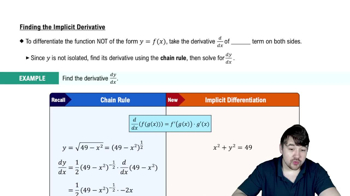Table of contents
- 0. Functions7h 52m
- Introduction to Functions16m
- Piecewise Functions10m
- Properties of Functions9m
- Common Functions1h 8m
- Transformations5m
- Combining Functions27m
- Exponent rules32m
- Exponential Functions28m
- Logarithmic Functions24m
- Properties of Logarithms34m
- Exponential & Logarithmic Equations35m
- Introduction to Trigonometric Functions38m
- Graphs of Trigonometric Functions44m
- Trigonometric Identities47m
- Inverse Trigonometric Functions48m
- 1. Limits and Continuity2h 2m
- 2. Intro to Derivatives1h 33m
- 3. Techniques of Differentiation3h 18m
- 4. Applications of Derivatives2h 38m
- 5. Graphical Applications of Derivatives6h 2m
- 6. Derivatives of Inverse, Exponential, & Logarithmic Functions2h 37m
- 7. Antiderivatives & Indefinite Integrals1h 26m
- 8. Definite Integrals3h 25m
4. Applications of Derivatives
Implicit Differentiation
Problem 69a
Textbook Question
The following equations implicitly define one or more functions.
a. Find dy/dx using implicit differentiation.
x+y³−xy=1 (Hint: Rewrite as y³−1=xy−x and then factor both sides.)
 Verified step by step guidance
Verified step by step guidance1
Rewrite the equation x + y³ - xy = 1 as y³ - 1 = xy - x to isolate the y terms on one side.
Differentiate both sides of the equation with respect to x, applying the product rule on the xy term and the chain rule on the y³ term.
After differentiating, collect all terms involving dy/dx on one side of the equation and move the other terms to the opposite side.
Factor out dy/dx from the collected terms to simplify the expression.
Solve for dy/dx by dividing both sides of the equation by the coefficient of dy/dx.
Recommended similar problem, with video answer:
 Verified Solution
Verified SolutionThis video solution was recommended by our tutors as helpful for the problem above
Video duration:
4mPlay a video:
Was this helpful?

 5:14m
5:14mWatch next
Master Finding The Implicit Derivative with a bite sized video explanation from Nick
Start learningRelated Videos
Related Practice



